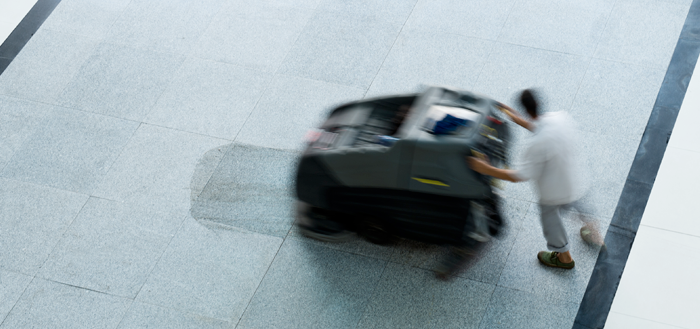
By: Briana Smith | December 9, 2014
Keeping your flooring looking great can take a bit of work, and each flooring type, whether it be natural stone, wood, VCT (vinyl composition tile), etc. has its unique set of challenges to take into consideration.
Softer flooring surfaces, such as VCT, marmoleum, linoleum, etc. typically need several layers of floor finish to protect the flooring material from the wear and tear of shoes that drag in dirt, sand and other debris from the out-of-doors. Synthetic flooring materials are very resilient and can be low-maintenance if you take care of them properly.
One of the less intensive ways to keep your synthetic floors looking brilliant is by scrubbing & recoating your floors, versus stripping them, when they no longer meet the acceptable level of appearance. The scrub & recoat procedure is part of the interim maintenance portion of your hard floor care cleaning program, and there are multiple benefits to performing this kind of maintenance.
Scrubbing & recoating…
- Reduces the manpower that’s needed to maintain flooring
- Keeps a higher acceptable level of glossiness to floor appearance for a longer amount of time
- Minimizes how often you have to strip floors
- Is less time intensive than a full restorative strip & recoat procedure
- Saves you money & extends the lifetime of the flooring material
How Scrubbing & Recoating Works
- The foundation of your floor finish base: First off, how you apply your floor finish is critical to how well your floors are going to hold up in general. You want to build a good base & then use the scrub & recoat procedure to maintain that base. Scrubbing & recoating will not fix problems with your base (i.e. dull spots, ridges that formed from puddles, etc.) in which case, stripping the floors would be the better option.
- Start out with dust & damp mopping: This will remove all of the loose dirt and sand from your floors making the next step more efficient.
- Remember to block off the area being cleaned & post wet floor signs
- Remove anything like gum that may need more work to remove: Using an autoscrubber or floor machine will get most of the job done, but certain materials tend to be more difficult to remove & it’s a lot easier to deal with them first before they get set-in.
- Scrubbing gets the dirt & soil off the top layer of your floor finish: Eventually debris from dirt and sand gets ground into your floors from every day foot traffic. It’s important to get all of this off before recoating, otherwise this dirt will just be embedded in the new layer of finish. A properly scrubbed floor will leave you with a good base for the finish recoat. Typically a general-purpose cleaner will work in this instance with a blue scrubbing floor pad.
- Clean up the ‘slurry’ left after scrubbing before it dries: Using a floor squeegee (with a mop and bucket), a wet/dry vacuum with a squeegee or an autoscrubber to clean as much up as possible.
- Rinse floor to get rid of any remaining residue: Sometimes you have to do this twice. Once mopping with a neutralizer/conditioner & another time with clean water. You want it to be as clean as possible as this’ll be the base for the finish recoat.
- Allow the floor to dry
- Recoat your floor: Follow normal floor finish procedures for application. Depending on the condition of your floors you may have to apply 2-4 coats of floor finish in even, thin to medium coats (factoring in enough dry time in between coats).
- Burnish your floors if desired: Once your floor is completely dry, you can burnish your floor for an enhanced gloss (if your finish allows for hi-gloss burnishing).
Optimally you’ll already be using the best combination of floor finish, floor machine, floor pad, etc. for your floors and keep up with daily dust & damp mopping to keep as much debris from being ground into your floor finish from foot traffic. This, in itself, will keep you from having to do more intensive maintenance as often.
Also, an entrance matting system will collect up to 80% of dirt at the doors of your building, minimizing the amount that will get tracked onto the floors. Prevention & basic maintenance is the key to good floor care maintenance.
READ MORE:
Carpet Care Surface vs. Deep Extraction: What's the Difference?
Is Stripping Your Floors Taking Too Long?
Is Your Stone Starting to Fade?
PDIR: R is for Restorative (Cleaning)
Step-by-Step Guide to Choosing a Floor Machine or Burnisher
Briana Smith is WAXIE’s Social Media & Product Branding Specialist and spends quite a bit of time skimming the news for what’s new in cleaning, sustainability and technology while managing all of WAXIE’s social channels. She especially loves posting about #teamwaxie activities & conversing with customers on Instagram. Briana has a Bachelor's Degree in Communication Design from California State University, Chico.


